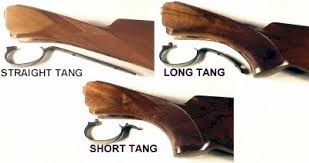Os pongo esto que he leído en una web USA y que me ha parecido muy interesante:
BROWNING SUPERPOSED: 1960-1976 MFG. In early 1960, a major change was made in the manner in which the various grades of Superposed were designated. The Roman numerals used in the 1950s were dropped, and Browning once again returned to names. The Pigeon, Diana, and Midas names used for pre-war designations were brought back and replaced the Grade II, Grade V, and Grade VI respectively. Grades III & IV were dropped and replaced by the Pointer. The Grade I remained unchanged.
The Broadway Trap Model was introduced in 1961. Browning's lifetime Superposed warranty began in 1963. During 1965, the Hydro Coil stock (1 year only) and barrel Super Tubes were introduced. During 1966, a major change was implemented to save money when Browning switched from a long tang to short tang. During 1970-71, the stock configuration was once again changed to a full pistol grip (referred to as flat knob), and the long tang was brought back. Also at this time, mechanical triggers were implemented vs. the older inertial design, and silver solder vent. ribs vs. tin solder. As a result, this period of Superposed manufacture was mechanically better and more reliable. The Superlight Model was introduced in 12 ga. during 1967, 20 ga. during 1969, and became available in all Grades beginning in 1971. All gauge Skeet sets became available in all Grades during 1972.
During late 1966, Browning's salt wood problems began to emerge, and continued until 1970. The majority of salt wood Superposed models from this era are in the round knob short tang configuration (RKST), but some flat knob short tang (FKST) guns with salt problems have also been observed. Depending on the damage (it can vary a lot), values for salt damaged guns can be reduced by as much as 50% (heavy pitting and original salt wood). Those salt guns that have been restocked by Browning are accepted by the shooting fraternity, and can command as much as 90% of the value of non-salt original guns. To determine if a Superposed has salt damage, examine carefully any gun where the serial number is within the 1966-1971 production range (please refer to the Browning Superposed serialization section), and carefully inspect the wood around the buttplate, forearm, and where the wood joins the receiver metal for any telltale rusting or pitting.
Engraved guns signed by Browning's top engravers (Funken, Vrancken, Watrin, Magis, Müeller, and J. Baerten) will command a premium over unsigned guns. Also, more and more Superposed models are appearing with Angelo Bee's signature (while non-factory, Mr. Bee's work is universally recognized. He engraved in Belgium at FN from 1951-1974.) Louis Vrancken and Andre Watrin took over as heads of the engraving department in 1960.
The following values are for 1960-1976 Superposed production non-salt damaged guns. Most desirable period of mfg. is 1960-1966 (round knob, long tang, limited salt, rarely encountered with salt damage). Guns made during 1972-1976 (FKLT) are worth more than RKST. Lowest values are for 1966-1971 mfg. (round/flat knob, short tang - should be inspected carefully for potential salt wood problems). Many Browning collectors/dealers feel that round/flat knob, short tang Superposed are getting harder to sell every year.
Barrel addresses appeared as follows: circa 1947-1958 "St. Louis, M.O." (earliest BAC markings) or "St. Louis, Missouri", 1959-1968 "St. Louis, Missouri and Montreal P.Q.", 1969-1975 "Morgan, Utah and Montreal, P.Q." Make sure barrel address date matches year of mfg. (see listings in the back of this text).
The original factory configuration of almost all Superposed shotguns can be verified by grade, gauge/bore, and barrel length. To obtain information on a specific Belgian Superposed serial number, please contact the Browning historian directly (refer to Trademark Index for more information).
-

- -presentacion.-hola-doy-comienzo-a-este-hilo-con-la-intencion-500975.jpg (7.54 KiB) Visto 2667 veces
Saludos








